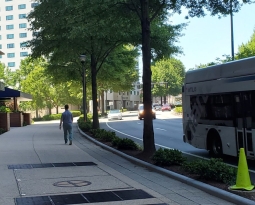Narrower Lanes for a Healthier Commute
Many commuters already know that speeding and reckless driving are major hazards, to both driver and pedestrian safety. Reckless drivers are not the only ones making commutes more hazardous, though. Last month, researchers at the Bloomberg School of Public Health at Johns Hopkins University released a study about the critical role of street design in traffic and pedestrian safety. The study found that narrower streets and lower speed limits dramatically reduced vehicle and pedestrian fatalities in urban and suburban streets.
The Georgia Department of Transportation requires a minimum lane width of 10-12ft for urban streets with travel speeds of both 25 miles per hour (MPH) and 35MPH. It is well known that travel speeds of 25MPH or lower significantly reduce pedestrian fatality rates. The new study from Johns Hopkins found that reducing lane widths from 11-12ft to 9-10ft led to similar reductions in pedestrian fatalities along streets with faster travel speeds, up to 35MPH. For streets with travel speeds of 25MPH or below, narrowing the lanes led to no significant reduction of pedestrian fatalities.
In November 2023, the Georgia Department of Transportation released its Vulnerable Roadway User Safety Assessment for fiscal year 2024. They found that the overall number of pedestrian and cyclist crashes on state-managed roads is increasing. Nearly 20% of fatal crashes in 2021 included a pedestrian or a cyclist.
Other benefits of narrower lanes? More opportunities for multimodal transportation! Reducing lane widths from 12 feet to 10 feet on a four-lane road creates 8 extra feet of right-of-way for pedestrians, cyclists, and other forms of transportation. Reducing both lane widths and the number of lanes in either direction may also create enough right-of-way to add bus lanes or space for above-ground light rail.
Safer streets are a major priority for transportation planners and engineers. Vision Zero is a nationwide movement focused on bringing the number of traffic fatalities to zero. This includes pedestrians, cyclists, and roadway users outside of personal vehicles. The City of Atlanta’s Department of Transportation is also focused on Vision Zero, and finished working on the citywide Vision Zero Action Plan this year.
So, how do we design safer, narrower streets? One method of doing so is to treat streets the same way we are treating parking requirements, by switching from a minimum requirement to a maximum requirement. Historically, developers had to follow minimum parking requirements for development. Communities used these tactics to reduce “less desirable” developments in their neighborhoods, which usually meant less multi-family housing in affluent, car-dependent suburbs. Because vehicle reliance is less pervasive in urban areas, many cities including Atlanta, are looking to remove parking minimums (and sometimes put forth parking maximums) to allow for more affordable, multi-family development.
Switching from minimum to maximum requirements for safer streets operates similarly. Rather than requiring that streets be at least 11-12 feet wide, transportation departments would instead put a cap on how wide lanes can be. Lanes would be at most 10 feet wide, and justification would be needed for wider streets.
Ultimately, planning narrower, safer streets relies on the priorities of the planners and agencies responsible for designing and maintaining those streets. Programs like Vision Zero and organizations like PropelATL are working to make streets safer for pedestrians and cyclists. The City of Atlanta and the Georgia Department of Transportation are actively researching and publishing strategies towards safer streets. Hopefully these policies will be put into practice sooner rather than later.








